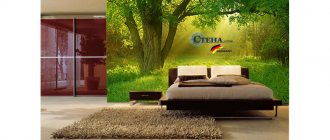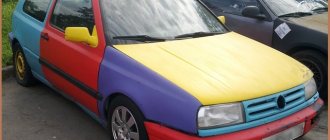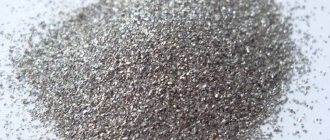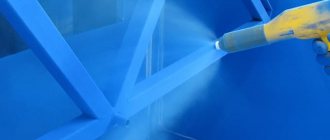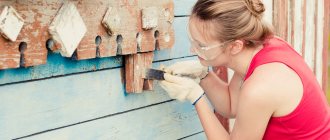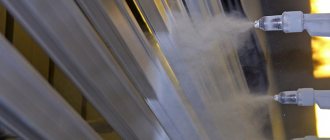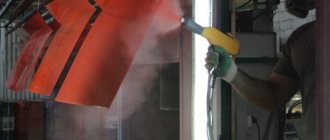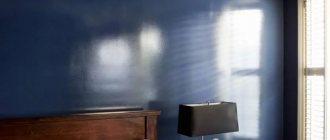In order for the garage to have a neat and finished appearance, it should be painted. Since each type of surface requires the appropriate paint and varnish material, you should first decide what types of paint you need to put your garage in order.
In principle, anyone can independently carry out exterior and interior painting. However, when choosing paint, it is worth considering the material from which the garage is built. If the walls are built from foam blocks, bricks or concrete slabs, then they must be plastered before painting, since putty is not suitable. This is due to the fact that the putty disrupts adhesion and the paint will not adhere to the surface.
Painting a metal garage
A metal garage without proper protective coating will quickly rust and become unusable. Therefore, when deciding which paint to choose for your garage, you must consider the following requirements:
- the paint coating must contain anti-corrosion additives;
- good resistance to temperature changes;
- resistance to humidity and aggressive atmospheric influences;
- quick drying of the paint layer.
The most popular in this regard are enamel paints, which have all of the above characteristics and will provide reliable protection for the metal surface of the garage for a long time. And the most common are silicone and alkyd enamels, which, however, are beginning to give way to more modern water-based acrylic paints. Due to their versatility, paints can be used for both exterior and interior painting.
Acrylic coatings, unlike organosilicon and alkyd compositions, do not contain solvents, as a result of which they are fire and environmentally safe. Regardless of the paint chosen, the surface must be primed.
Important! Experts recommend purchasing primer and paints from the same manufacturer. Thus, the quality of the coating is greatly improved.
Tools and materials for painting
Tools for painting garage doors
To work, take moisture-resistant anti-corrosion paint for garage doors, use a primer and solvent. Wash the surface with liquid soap; for oily surfaces, use preparations with an anti-greasy effect. Removers are chosen depending on the type of old coating; there are preparations for oil, acrylic, and powder layers.
Tools for work:
- step ladder;
- hose, sponge, rags;
- grinder with a grinding wheel, spatulas.
- roller, brushes, spray gun, spray gun.
The paint is diluted in ditches, which have an inclined plane for squeezing out the paint.
The edges of the area to be painted are separated from other elements using masking tape so as not to paint over excess.
Brushes are chosen with artificial bristles; flat and round types are used. Special corner rollers are produced for corners; it is better to use attachments with a velor surface.
The choice of paints and varnishes for garages made of brick, foam blocks and concrete slabs
The most optimal paint and varnish materials for painting a garage made of concrete, brick or stone are polymer-based paints. Moreover, each variety has its own advantages:
- epoxy primer enamels can be applied without prior priming the surface;
- perchlorovinyl compounds are highly resistant to low temperatures;
- polyurethane paint for concrete has high wear resistance and resistance to chemicals;
- water-based acrylic coatings can be applied even to fresh plaster and have high weather resistance;
- polymer paints can be used both indoors and outdoors;
- For outdoor work, quick-drying nitro enamels are best suited.
Completing of the work
Then you can proceed directly to the work, which consists of several stages:
- The most important point is the purchase of material. First, you should find out how much the chosen paint, primer, remover, solvent, and so on will cost. After all, the price of finishing will largely depend on the components
- We prepare the tools: brush, roller, if required – stepladder, sprayer, paint container;
- If the garage has previously been painted, the old coating must be removed. This can be done using a drill with an abrasive attachment or a metal brush, wash and a hair dryer.
- After this, sand the metal with emery cloth;
- The surface is then degreased on its own using a solvent.
- The metal is primed. This will help improve the adhesion of the base and paint and protect the entire surface from corrosion. The primer will also make the base level, which improves the quality of painting.
- Once the primer is completely dry, the surface is washed with water. This is necessary to remove dust and dirt.
- Painting the walls with a roller is done from top to bottom strictly in a vertical direction. This makes it much easier to remove drips if they appear. A spray bottle can help with this job. Then the dye will penetrate into all inaccessible places and the coating will last much longer.
Attention: The instructions say to apply each strip, slightly overlapping the previous one. In this case, the coloring will be uniform, without any transitions or omissions.
- Complex areas such as corners and edges are painted with a brush. After twenty-four hours, the coating will dry and you can apply another coat of paint. This is done in a horizontal direction.
Paint for brick and concrete buildings
The best paint for a garage made of similar materials - all types of brick, concrete - should be polymer-based.
Each type of such compositions will have its own advantages:
- Epoxy primer-enamels are applied without a preliminary primer base for painting;
- Perchlorovinyl paints tolerate low temperatures well;
- Water-emulsion acrylic compositions can be applied to freshly laid concrete, as well as plaster. Among other things, they have good weather resistance;
- Polyurethane paint for concrete has increased wear resistance and chemical resistance.
Polymer coatings can be used not only outside the room, but also inside it. If necessary, they can be painted in any tones and shades.
For these purposes, pastes and tinting paint are used. The compositions will most reliably protect concrete walls, ceilings and floors from aggressive environments, moisture and mechanical loads. Special paints are designed to increase the service life of the base and strengthen it.
Painting a metal garage is not a complicated process, but it is quite painstaking. There's no need to rush. Make sure the surface is properly prepared. The instructions will help you not to miss anything, and after looking at the photo and drawing up a work plan, you can start working on it.
Category: Garage › Finishing, wiring, cellar Date: 2013-07-15 17:19:23 Painting a garage brings many benefits: it increases the service life of the structure, and also makes it more attractive. We have already looked at how to paint a garage
, now let’s talk about the features of choosing a paint and varnish material. It is no secret that different types of paints are made for different types of surfaces. Metal paints are even separated into a separate market segment. They can be used for any construction or major repairs; they are also used for painting a garage.
Now let's talk about what color to paint the garage.
. Theoretically, it is possible in any. But there are general principles that should be followed. For example, it is good if the car house has a color that harmonizes with nearby buildings. On the other hand, the color should be pleasant to its owner. And one more important point: try not to make the paint too bright. Poisonous red or green colors are not the best choice. In addition, after rain, dust and dirt will stick to the surface. Try to choose a paint that won't show much dirt.
Choosing paint for the garage
It is generally accepted that metal is durable and unpretentious, but it is important to understand that it is quite sensitive to temperature changes, environmental influences and humidity. The metal can corrode, causing it to become less durable and wear out quickly. Thanks to the right paints, you can protect its surface.
No matter what high-quality and expensive paint you use, it is important to treat the base with a primer mixture before applying it. Now let’s move on directly to considering the main types of paints for metal.
Oil paints can be used to paint metal surfaces. When the material hardens, it forms a film; over time, under the influence of external factors, it can dry out or disappear. This causes the paint to crack or peel. Therefore, oil-based paints are not the best choice for painting a garage.
Acrylic paints - a modern, effective material
Acrylic paints have become especially popular for painting metal substrates. They allow you to process surfaces of any area. Of course, they cost more than their oil counterparts, but their durability and strength are an order of magnitude higher. In addition, acrylic paints provide protection from temperature changes and the destructive effects of the external environment, which prevents corrosion processes.
Acrylic paint can be applied even to a small area of rust, since it contains special additives. They are the ones who stop corrosion processes and remove the resulting rust. Therefore, if you are looking for something to paint a metal garage,
take a good look at acrylic paints.
For garages that are completely covered with rust, the surface must first be treated with anti-corrosion acrylic primer, which contains a rust converter. Only after this can the base be coated with acrylic paint.
Paint for concrete floor in garage
Most people believe that staining a concrete garage floor is not practical. However, concrete is also susceptible to various elements, and painting it will give the floor additional protection.
Basically, for painting concrete floors in garages, alkyd and epoxy paints are used, which have high anti-slip and antistatic characteristics and high resistance to chemical reagents. Epoxy compositions must be mixed before use, while alkyd paints are sold completely ready for use.
Attention! Before painting a concrete floor with alkyd paints and varnishes, the surface should be primed, whereas this is not required when using epoxy compounds.
Paint requirements
The paint composition must correspond to the conditions in which the garage is operated:
- According to statistics, only every twentieth garage is heated on a regular basis. In other cases, there is no heating system. Lack of heating in damp conditions leads to the formation of mold. Thus, the paint must contain bactericidal additives and also be resistant to low temperatures. If the paint does not contain bactericidal substances, it is necessary to coat the surface (both outside and inside) with an antiseptic composition before painting.
- The coating should not be too light or bright, since the conditions in which the garage is operated involve the presence of dirt, soot and dust. The best color background option is dark and non-staining.
- If the garage is frequently cleaned, then for the above reasons the surface will have to be scrubbed quite intensively. This leads to another recommendation: the coating must be resistant to friction.
- The material that will be painted also needs to be taken into account. For concrete, one type of paint is better, for metal - another.
- The paint and varnish material must be fireproof, since there are fuels and lubricants in the garage.
- Coatings (especially floors) must be resistant to mechanical stress.
- The garage space is operated under conditions of interaction with chemicals: drops of oil or gasoline fall on the floor, exhaust vapors penetrate into the air, etc. Therefore, the paint must be resistant to aggressive environments.
- The coating must be resistant to the absorption of odors.
- If we are talking about a metal garage, the paint must contain anti-corrosion additives.
Read this article on how to paint a concrete garage floor.
Painting a concrete floor
Before painting the garage floor, you need to prepare the concrete base. To do this, the surface is cleaned of dust and dirt, uneven areas are sealed with putty or mortar, and only then paint is applied.
The paintwork should consist of 2-4 layers. The paint is applied at a temperature of the treated substrate not lower than +5˚C, ambient temperature not lower than +10˚C and air humidity not higher than 80%. Concrete floors can be painted no earlier than 5 days after pouring. The next coat of paint should be applied only after the previous one has completely dried, which is usually about 24 hours.
When choosing paints and varnishes for painting a concrete garage floor, you should definitely take into account the ability of the paint composition to withstand a wide variety of temperature changes, resistance to long-term high loads and other operating features typical of a garage.
Reasons why you may need to paint your gate
Why do garage doors look unpresentable? This is primarily due to the fact that, being outside, they are constantly exposed to atmospheric phenomena - temperature changes, precipitation, hurricanes. The hot sun has a negative effect on the paint of the gate - it fades over time and loses its attractiveness. A hurricane or strong wind carrying debris leaves minor damage to the gate; moreover, it can be caused during operation. And moisture from rain and snow entering these damages starts the corrosion process.
In winter, garage doors suffer from both humidity and strong winds and snow.
The gates on the sunny side have faded
If the gate is located on the south side, it is not surprising that the paint on it will fade much faster than on the opposite side. There is no way to avoid this, but you can delay the moment. To do this, choose compositions that are less prone to fading. First of all, these are acrylic and silicone paints. Another advantage of silicone is that it is not afraid of acids and alkalis.
On the sunny side it is better to install light-colored gates painted with ultraviolet pigment.
To avoid a recurrence of the problem, it is important to take seriously the issue of choosing what paint to paint garage doors on the sunny side, because the paint must be special. You can take a closer look at formulations with light-resistant pigments, although they will cost more
The gate is covered with rust
Iron, whatever one may say, is very susceptible to corrosion, and in those moments that concern street structures, it is almost impossible to avoid this problem. Therefore, gates that have already rusted once require regular painting.
What is the advantage of high-quality branded gates in this case? The fact is that they are painted in production using a special technology that is not available in everyday life. The metal is first painted and baked in special ovens, and only then the molds are filled with foam. After such painting, the gate holds the coating much better, thereby reducing the risk of corrosion. If you also use them carefully, you may not encounter the problem of rusting at all.
Rusty garage door
If rust does become your problem, pay special attention to preparing the metal for painting - it is at this moment that the service life of the new coating is established. If painting is carried out carelessly, on an uncleaned surface, the rust will quickly return to its place.
I would like to update the color and paint over minor defects
Sometimes traces of long-term use do not interfere with functionality, but spoil the appearance. For example, a large number of small scratches, chips, and uneven color irritate the eye so much that you want to do something about it. In this case, some owners think about how to decorate the gate to make it more attractive, but most do not find acceptable options other than updating the coating. In this case, you should take on painting if you are confident that you will do better. Do-it-yourself painting work often does not give the expected result, as we see on the Internet in the blogs of handymen.
Scratched metal looks unsightly
Removing the factory paint layer will be quite problematic because, as mentioned above, it is applied using a special technology, which gives it special strength. So, to update the color, it is better to choose the one that is “native” for your gate.
Painting the walls
The optimal solution for painting garage walls are silicate paints and varnishes, which are made from potassium glass. Such coatings do not fade, are abrasion resistant and durable. Used for painting brick, stone, concrete and plastered surfaces.
Polysilicon compositions based on silicone resins are considered even better to use than silicate paints. They hold up well even on organic plaster. Such paints allow air to pass through and retain moisture. The only drawback is the relatively high cost of this paint and varnish material.
However, the most common for painting the interior surface of garage walls are water-dispersed paints based on acrylic organic resins. Such paints and varnishes repel dust and dirt, but are not used for painting silicate and limestone surfaces.
